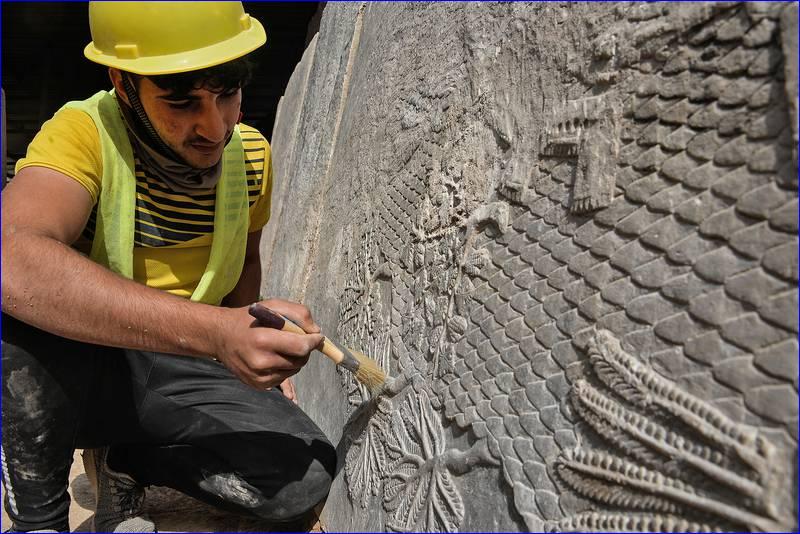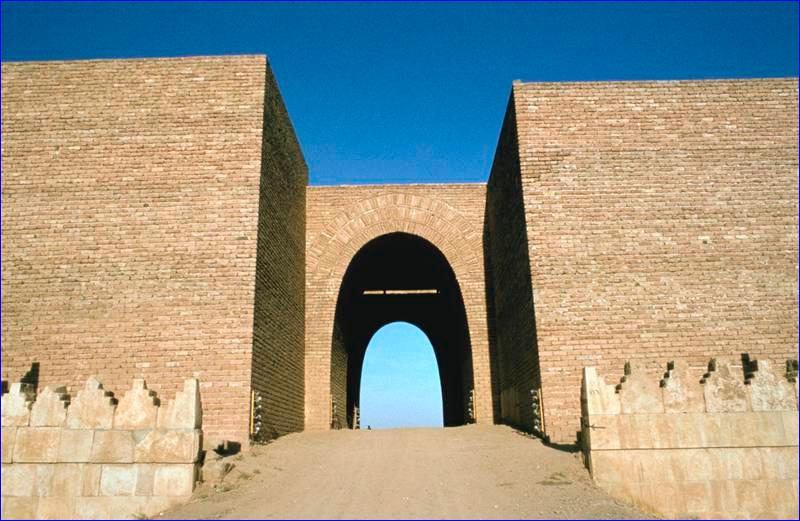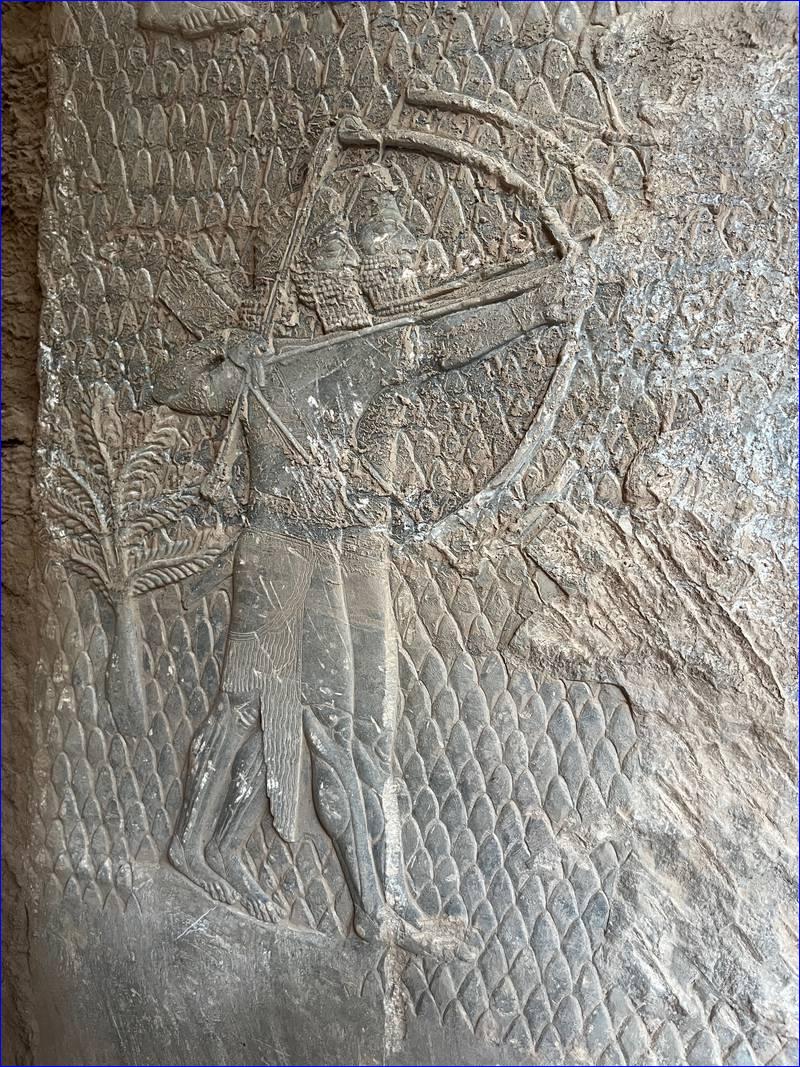


 AFP)
AFP)
Now, they are beginning the next phase of work, exploring new areas for excavation and starting on the gate's reconstruction. They will commission a new kiln to re-create the earthenware bricks used by the Assyrians millennia ago, in a major capacity-building project under Iraq's State Board of Antiquities and Heritage.
The team arrived in 2021 to excavate the Mashki Gate after its Saddam Hussein-era reconstruction was destroyed by ISIS. When they spotted the top of a carved figure of an archer reaching out from what they assumed were stone foundations, they began digging towards the bottom-most layer of the gate, which was built in 700 BC.
"It blew me away," says project manager and archaeologist Michael Danti, who is directing the dig with the Iraqi archaeologist Fadhel Mohammed Khdir Ali of the SBAH. "On the lower 30 to 40cm [of the reliefs] we have probably the best preserved portions of Sennacherib reliefs anywhere -- because they're pristine. They've never suffered from fire damage or the elements. They're really spectacular," adds Danti.
The seven carved panels came from the South West Palace -- known as "the palace without rival" from its inscriptions -- that was established by the Assyrian king Sennacherib, a prominent member of the Sargonid dynasty. Sennacherib, who ruled from 705 BC to 681 BC, made Nineveh his capital, raising it from a provincial town to a vast metropolis.
The Mashki Gate reliefs bear inscriptions from his reign on their reverse side, and match others from the Palace in style and subject. Many of those panels, which were discovered during the first excavation of the Nineveh in the mid-nineteenth century, are now in the British Museum.
The reliefs depict Sennacherib's third military campaign, which was waged in the West against the Phoenicians and the kingdom of Judah. Some show finely detailed archers, with tightly curled beards, pulling back their strings as they prepare to launch arrows. Others depict the landscape they fought in, with individually carved leaves, their veins visible, or groves of small wooded trees.
Another relief, which like the others, was carved in alabaster and would have originally been painted, shows the encircled city of Lachish, which was captured by Sennacherib's forces in 701 BC.

 Getty Images)
Getty Images)
A moment of artistic flowering
Making the discovery even more exciting is that Sennacherib instituted an important period of stylistic change in Assyrian culture. "Unlike earlier rulers, who documented their military successes in cuneiform inscriptions, Sennacherib only wrote a short inscription on the back, attesting to the fact that he commissioned the reliefs, and let the vivid depiction instead reveal his military prowess," says Danti.
"Another innovation was his use of time among the sequencing of the reliefs: rather than trying to encapsulate one moment within one relief, he arranged them in sequences, so that the audience could follow the story of the campaign."
Like the South West Palace, the original floor of the Mashki Gate dates back to Sennacherib. Over the subsequent century, two further reconstructions were made that each added a new floor. When the Babylonians sacked Nineveh in 612 BCE, they burned Mashki Gate, which had been erected with baked bricks around a timber support. That left the last of the three levels in a "Pompeii"-like state, with its fighters and their weapons trapped inside.
It was this scene that was excavated in the late 1960s by the Iraqi archeologist Tariq Madhloom, who has also worked in the region of Mleiha in Sharjah. Madhloom recreated two walls of the gate, which were then targeted as examples of the pre-Islamic past after ISIS took over the Mosul region in 2014, and were entirely destroyed.
Still a mystery
The team, comprised of archaeologists from Iraq and the University of Pennsylvania's Iraq Heritage Stabilisation Program, have now been studying the reliefs for a year, but questions remain. Why were these reliefs were used as a foundation? And instead of going through the effort to chisel out the designs -- Danti and his team also found the shards of stone and, in one case, a 8th-century BC chisel itself -- why didn't they simply plant them in the ground facing outwards, with their blank backs creating the visible foundations for the gate? And who reused them?
Whoever installed the reliefs tried to remove the depictions, hacking away at them with chisels. And because these panels, like the others, have been preserved in the ground, the chisel marks themselves look like they were made yesterday -- so much so that reports in local media alleged they had been made by ISIS.

 Melissa Gronlund)
Melissa Gronlund)
The current working hypothesis is that the pieces were moved during the reign of King Ashurbanipal, whose violent reign helped hasten the decline of the Assyrian Empire. It is known that Ashurbanipal constructed a new palace in Nineveh, and the dates between the construction of the third level of the gate and the Ashurbanipal's tenure overlap. But this will have to be confirmed by further study, as the team -- its process halted by the discovery -- continues its project of excavating down to the original Sennacherib floor.
Future
The long-term plans for Mashki Gate will be to partially reconstruct it, in order to show its historical importance. Right now, the site for the Gate, which lies about 600 metres from the Palace, are grassy, undeveloped fields, strewn with rocks and archeological remains. Across the busy road from the site is eastern Mosul, the new town, whose riverside cafes and restaurants buzz with the excitement of a city keen to enjoy some peace and security.
Any reconstructions will go forward with the buy-in of this local population, as the State Board of Antiquities and Heritage treads lightly through the reconstruction.
The excavations elsewhere in Nineveh are being undertaken by Italian and German archaeological teams, who typically have more university funding for such expeditions than their US and UK counterparts. Danti's team is funded by Aliph and University of Pennsylvania, and coordinated by the SBAH.
Whether the reliefs will remain in place or go to a museum, in Mosul or elsewhere, is yet to be decided.

or register to post a comment.